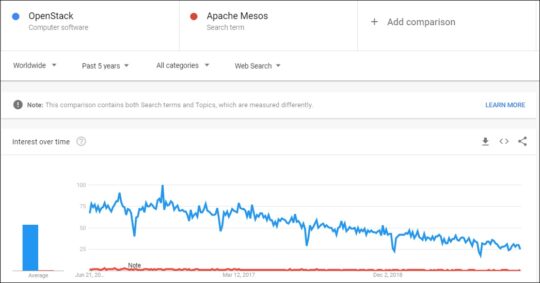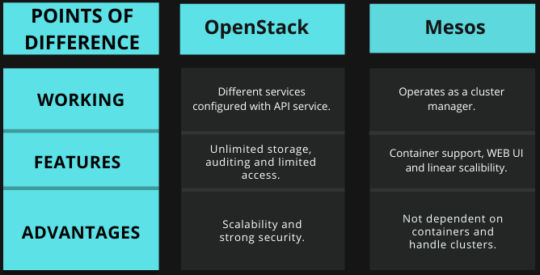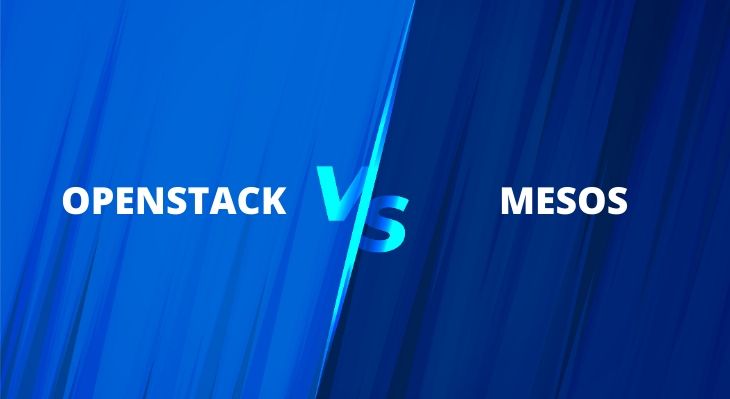Cloud platforms have been a saviour for businesses relying on them.
However, to efficiently manage the cloud working users are dependent on specific platforms that help in its smooth functioning.
OpenStack and Apache Mesos are two open-source platforms that help with efficient management and effective deliverance of cloud services.
OpenStack is an open-source platform that uses virtual resources to manage the public as well as private clouds.
Apache Mesos is a cluster manager.
It helps in simplifying the complexity of running applications on multiple shared pool servers.
Understanding the Difference between OpenStack and Mesos

From Google search results of the past five years, it is quite clear that OpenStack is quite ahead in terms of popularity as compared to Apache Mesos.
OpenStack has been created with a combination of different services that are further configured with an API service internally.
Every service is authenticated with Keystone or Identity services.
Some of the individual services can interact with one another while some of them require the permission of admins.
Advance message queuing protocol is used for communicating among the processes within the services.
Apache Mesos consists of below components:
- Mesos Master
- Mesos Agent
- Scheduler
- Executor
Mesos Master is the main part of the cluster ensuring the availability of clusters. It stores all of the data that is related to the tasks.
Mesos agent acts as the intermediate between the local executor and Mesos Master. It ensures the delivery of status updates of the tasks assigned to Schedulers.
The architectural framework of Mesos consists of two agents; agent1 and agent 2 which acts as Executor.
It consists of an application module that acts as a Mesos Master.
Two frameworks; framework1 and framework2 act as Schedulers.
Let’s understand the working now.
- Agent 1 informs the master about its availability with say 4 CPU and 4GB of memory available.
- Master hereafter describes what is available on agent 1 to framework 1.
- The framework then provides the information of tasks to be run on agent 1.
- In its first task provided by frameworks, the agent uses 2 CPU and 1GB RAM.
- In its second task agent uses 1 CPU and 2GB RAM.
- Master hereafter is responsible for sending the task to the agents allocating necessary resources to the framework executors.
Also, Read Fog Computing Architecture: Everything You Need to Know
Features of OpenStack are as under:
- Unlimited Storage: Users would be able to serve content directly from storage.
- No Central Database: Results in higher performance and no bottlenecks.
- Drive Auditing: Reduces data corruption by detecting drive failures.
- Restricted Access: Limits the control access according to user usage.
- Real-time Client Observing: User requests can be observed.
Let us discuss some of the features of Mesos:
- Container Support: Supports the launching of containers with the help of Docker and AppC images.
- WEB UI: Built-in user interface for navigating container sandboxes.
- Cross-Platform: Runs on multiple platforms like Linux, OSX, and Windows.
- Two Level Scheduling: Users can run cloud-native as well as legacy applications in the same cluster.
- Linear Scalability: Easy scaling of up to 10,000 nodes.
Some of the advantages of OpenStack are as under:
- Cuts Down Time-to-Market: Faster deployments of IT resources saves a lot of time.
- Scalability: Users can spin up and spin down servers on –demand.
- Free from Vendor Lock-in: Supports a variety of proprietary technologies and can operate in bare-metal environments.
- Strong Security: OpenStack security project is maintained by the vulnerability management team, whose main job is to find and fix security issues.
- Multiple Services for Multiple Tasks: For OpenStack services like Neutron, Nova, Cinder, and Glance are provided.
Whereas for cloud computing tasks Nova is used for computing, Neutron for networking, Cinder for storage.
Below mentioned are some of the advantages of Mesos
- Supports non-containerized native processes.
- Mesos Schedulers can handle standard lifecycles like Marathon, Aurora, etc.
- Better equipped to handle cluster and node lifecycle events.
- It is not dependent on containers for using container images.
- It makes it easier to write customer schedulers wherein it has to handle application lifecycle management.
Below mentioned are some of the customer reviews for OpenStack, taken from featuredcustomers.com.
- To enable customers to execute payments anytime anywhere, PayPal moved to the cloud-powered by OpenStack for agility and availability.
- With the help of OpenStack, Liveperson was able to cut down on costs and scale up on the virtual machines.
Some of the customer reviews for Mesostaken from g2.com
- A big data developer reviewed Mesos by stating the fact that, users can launch Spark tasks in a Mesos cluster by just mentioning the Mesos Cluster URL. And it integrates with Apache Spark too.
- Running and setting up Mesos in a cluster on standard hardware is quite easy as reviewed by a lead software engineer. It works quite efficiently in a virtual environment too.

Conclusion
Modern trends of businesses are dependent on cloud platforms and might need multiple distributed systems for specific tasks. OpenStack and Mesos can prove quite beneficial in the smooth functioning of cloud platforms.
Also Read:
Understanding LAMP Stack and Its Applications
OpenVAS vs. Nessus: Detailed Comparison of the Two

